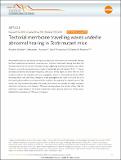| dc.contributor.author | Ghaffari, Roozbeh | |
| dc.contributor.author | Aranyosi, Alexander J. | |
| dc.contributor.author | Richardson, Guy P. | |
| dc.contributor.author | Freeman, Dennis M. | |
| dc.date.accessioned | 2015-04-09T16:12:02Z | |
| dc.date.available | 2015-04-09T16:12:02Z | |
| dc.date.issued | 2010-10 | |
| dc.date.submitted | 2010-04 | |
| dc.identifier.issn | 2041-1723 | |
| dc.identifier.uri | http://hdl.handle.net/1721.1/96488 | |
| dc.description.abstract | Remarkable sensitivity and exquisite frequency selectivity are hallmarks of mammalian hearing, but their underlying mechanisms remain unclear. Cochlear insults and hearing disorders that decrease sensitivity also tend to broaden tuning, suggesting that these properties are linked. However, a recently developed mouse model of genetically altered hearing (Tectb[superscript −/−]) shows decreased sensitivity and sharper frequency selectivity. In this paper, we show that the Tectb mutation reduces the spatial extent and propagation velocity of tectorial membrane (TM) travelling waves and that these changes in wave propagation are likely to account for all of the hearing abnormalities associated with the mutation. By reducing the spatial extent of TM waves, the Tectb mutation decreases the spread of excitation and thereby increases frequency selectivity. Furthermore, the change in TM wave velocity reduces the number of hair cells that effectively couple energy to the basilar membrane, which reduces sensitivity. These results highlight the importance of TM waves in hearing. | en_US |
| dc.description.sponsorship | National Institutes of Health (U.S.) (Grant R01-DC000238) | en_US |
| dc.description.sponsorship | National Institutes of Health (U.S.) (Harvard University--MIT Division of Health Sciences and Technology. Speech and Hearing Bioscience and Technology Program. Training Grant) | en_US |
| dc.language.iso | en_US | |
| dc.publisher | Nature Publishing Group | en_US |
| dc.relation.isversionof | http://dx.doi.org/10.1038/ncomms1094 | en_US |
| dc.rights | Creative Commons Attribution-NonCommercial-Share Alike | en_US |
| dc.rights.uri | http://creativecommons.org/licenses/by-nc-sa/3.0/ | en_US |
| dc.source | Nature Publishing Group | en_US |
| dc.title | Tectorial membrane travelling waves underlie abnormal hearing in Tectb mutant mice | en_US |
| dc.type | Article | en_US |
| dc.identifier.citation | Ghaffari, Roozbeh, Alexander J. Aranyosi, Guy P. Richardson, and Dennis M. Freeman. “Tectorial Membrane Travelling Waves Underlie Abnormal Hearing in Tectb Mutant Mice.” Nature Communications 1 (December 19, 2010). | en_US |
| dc.contributor.department | Harvard University--MIT Division of Health Sciences and Technology | en_US |
| dc.contributor.department | Massachusetts Institute of Technology. Department of Electrical Engineering and Computer Science | en_US |
| dc.contributor.department | Massachusetts Institute of Technology. Research Laboratory of Electronics | en_US |
| dc.contributor.mitauthor | Ghaffari, Roozbeh | en_US |
| dc.contributor.mitauthor | Freeman, Dennis M. | en_US |
| dc.contributor.mitauthor | Aranyosi, Alexander J. | en_US |
| dc.relation.journal | Nature Communications | en_US |
| dc.eprint.version | Final published version | en_US |
| dc.type.uri | http://purl.org/eprint/type/JournalArticle | en_US |
| eprint.status | http://purl.org/eprint/status/PeerReviewed | en_US |
| dspace.orderedauthors | Ghaffari, Roozbeh; Aranyosi, Alexander J.; Richardson, Guy P.; Freeman, Dennis M. | en_US |
| dc.identifier.orcid | https://orcid.org/0000-0001-6309-0910 | |
| dc.identifier.orcid | https://orcid.org/0000-0003-3369-5067 | |
| mit.license | PUBLISHER_CC | en_US |
| mit.metadata.status | Complete | |
